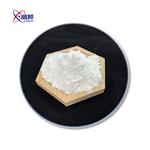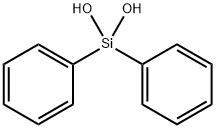Diphenylsilanediol: From High-Performance Polymers to Veterinary Antiepileptics
Diphenylsilanediol(DPSD) is an alkoxysilane that is used as a silane based precusor in the synthesis of organosiloxane based resins. DPSD may be used as a precursor in the synthesis of linear vinyl oligosiloxane resins which can be potentially used in the fabrication of thermally resistant light emitting diode(LED) encapsulant. Mercaptopropyl-phenyl-oligosiloxane and phenyl-vinyl-oligosiloxane may be synthesized by using Diphenylsilanediol which can further be used as a thiolene derived dielectric layer for organic thin film transistors.

Poly(butylene glycol adipate-co-terephthalate/diphenylsilanediol adipate-co-terephthalate) Copolyester
Since the rapid development of the plastics industry in the 1950s, plastics have been widely used in food packaging, agricultural mulch, construction, tissue engineering and other fields. According to statistics, the annual global production of plastics has reached 350 million tons and is increasing year by year. The main chain of silicone resin is composed of Si-O bond, and the bond energy of Si-O bond is larger than that of the C-C bond and the C-O bond, so the weathering and heat aging resistance of silicone resin are obviously better than that of epoxy resin. Diphenylsilanediol is a very useful intermediate for the synthesis of silicone materials. Guo Hong et al. The results showed that the refractive index of the film increased with the increase in DPSD content, and the thermal conductivity, thermal stability, and light transmittance were also improved; Shufang Jiang et al. synthesized a series of diphenylsilanediol-modified epoxy resins and a new type of curing agent, and the results showed that the application of the modified resins and the newly synthesized curing agent resulted in the lowering of the rate of thermal decomposition of the cured products. Therefore, the addition of DPSD to polyester can improve the heat resistance, thermal stability and thermal decomposition of the material.[1]
As the DPSD content increases, the polymer molecular chain becomes rigid and the corresponding polyester flowability deteriorates, as evidenced by the change in the MI value from 2.83 g/10 min of 1# to 2.54 g/10 min of 5#. When the Diphenylsilanediol content reaches 12.5%, the MI is 2.54 g/10 min, which is theoretically more suitable for extrusion processing. PBDAT copolyester was successfully prepared by the esterification polycondensation reaction using AA, PTA, BDO, and Diphenylsilanediol as raw materials. PBDAT copolyester has good processing properties and excellent thermal stability. The tensile strength and the elastic modulus of PBDAT were both improved, reaching 30.56 MPa and 238 MPa, respectively, with an increase in Diphenylsilanediol content, which broadened the use of the copolyester. However, with the introduction of DPSD, the copolyester becomes less hydrophilic, but can still be degraded in alkaline solution. The highest alkali degradation rate reached 9.7% in 32 days, which is very friendly to the environment.The results are of guiding significance for the study of PBAT molecular chains and provide a new direction for the design, synthesis and development of new polyester materials.
Clinical evaluation of the new compound diphenylsilanediol
A controlled clinical trial of the anti-epileptic efficacy and toxic side effects of diphenylsilanediol was conducted on 24 client-owned epileptic dogs. Data obtained from an abbreviated procedural treatment program indicated that diphenylsilanediol compared favorably with primidone as an anti-epileptic compound, but had limiting toxic side effects to the liver, pancreas, and possibly to other tissues. There was a mean reduction of 60.7% in seizure frequency in 15 epileptic dogs treated with diphenylsilanediol when compared with their pretreatment frequency. There was a mean reduction of 55.6% in seizure frequency in 9 spileptic control dogs treated with primidone. Samples of blood obtained from the dogs in the program on the different weeks of treatment were examined for complete blood cell count, blood urea nitrogen, liver function, and pancreatic function. Toxic side effects were not seen among the primidone-treated control dogs, with the exception of occasional dose-related drowsiness. Among the diphenylsilanediol-treated dogs, 3 developed liver disease, 2 developed definite pancreatic changes, and 2 showed evidence of bone marrow suppression. Four dogs died during treatment with diphenylsilanediol, whereas no deaths occurred during the same interval of primidone therapy.[2]
References
[1]Ge T, Wang M, He X, Yu Y, Liu X, Wen B, Liu P. Synthesis and Characterization of Poly(butylene glycol adipate-co-terephthalate/diphenylsilanediol adipate-co-terephthalate) Copolyester. Polymers (Basel). 2024 Apr 17;16(8):1122. doi: 10.3390/polym16081122. PMID: 38675041; PMCID: PMC11054650.
[2]Cunningham, J G et al. “Clinical evaluation of the new compound diphenylsilanediol for ani-epileptic efficacy and toxicity.” American journal of veterinary research vol. 42,12 (1981): 2178-81.
See also
Lastest Price from Diphenylsilanediol manufacturers

US $1.10-9.90/kg2025-08-18
- CAS:
- 947-42-2
- Min. Order:
- 1kg
- Purity:
- 99%min
- Supply Ability:
- 100kg

US $10.00/KG2025-04-21
- CAS:
- 947-42-2
- Min. Order:
- 1KG
- Purity:
- 99%
- Supply Ability:
- 5tons


